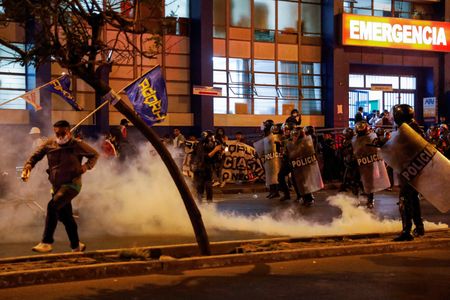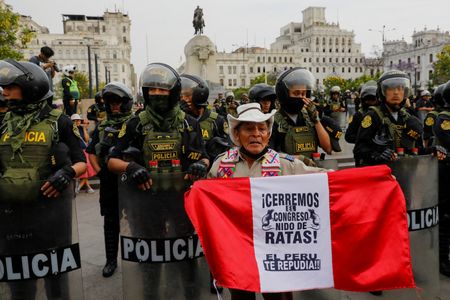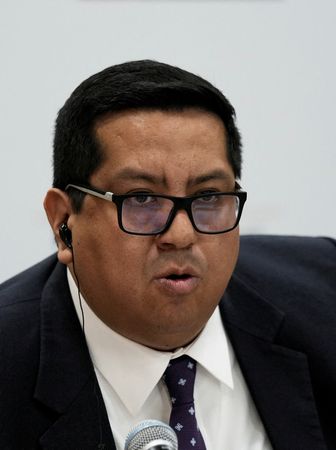By Marco Aquino
LIMA (Reuters) -Peru’s new government is looking at economic stimulus measures for regions being roiled by protests after the ouster of leftist leader Pedro Castillo, but will hold steady to “non-negotiable” fiscal deficit targets, the economy minister said on Tuesday.
The Andean nation, the world’s no. 2 copper producer, was thrown into disarray last week when Castillo was ousted by Congress and arrested, sparking off protests in rural mining regions that have left at least six people dead.
The political turmoil is increasingly threatening to derail Peru’s economic stability, with ratings agencies warning of downgrades, blockades impacting major mines and protesters demanding Congress and new president Dina Boluarte step down.
“We do not rule out some measures to try to generate reactivation in particular in these areas of convulsion, we recognize that there is discontent among citizens,” Economy Minister Alex Contreras told Reuters in his first interview with international media.
Amid warnings from ratings agencies about the economic impact of the unrest and possible elevated spending, Contreras pledged that fiscal responsibility would be maintained.
“The fiscal deficit (target) is something for us that is not negotiable,” he said, adding the government needed to take “very fast measures” to stimulate growth, but “that can be executed with the balances that we are going to have this year”.
Peru is aiming for a fiscal deficit of 2.5% of GDP this year and 2.4% next year. The 2022 growth outlook was cut last month to between 2.7% and 3%, below the 3.3% previously forecast.
Contreras said that the economic impact of the protests, which started just under a week ago with calls for rapid new elections, was around 80 million soles ($21.05 million) per day.
“The impact of the protests is limited, we believe that they will moderate in the following days,” he said, adding the unrest would not force the government to change its outlook for 2023.
“We are not going to review the projections.”
‘UNBREAKABLE’
Boluarte, formerly vice president, has pledged to bring forward the next general elections by two years to 2024, though that has failed to bring an end to protests.
On Monday, ratings agency S&P cut Peru’s outlook to negative from stable and warned about a possible ratings downgrade if the upheaval continued.
Contreras said that he had spoken with S&P and Fitch and understood their concerns, but highlighted Peru’s fiscal and monetary strength, which he said was a buffer for the economy.
“The greatest concern (for them) is something that has never happened in Peru, even in a context of volatility, that the political upheaval could end up generating some disruption in the management of fiscal accounts,” he said.
Contreras, who was formerly vice economy minister and worked for years in the ministry and central bank, talked up the technocrat nature of the new Cabinet.
“That helps a lot with confidence,” he said. “In the ministry we talk about resilience, we have an unbreakable strength due to its monetary and fiscal pillar, that remains in force, but there is always some risk.”
($1 = 3.8002 soles)
(Reporting by Marco Aquino; Writing by Adam Jourdan; Editing by Himani Sarkar)



